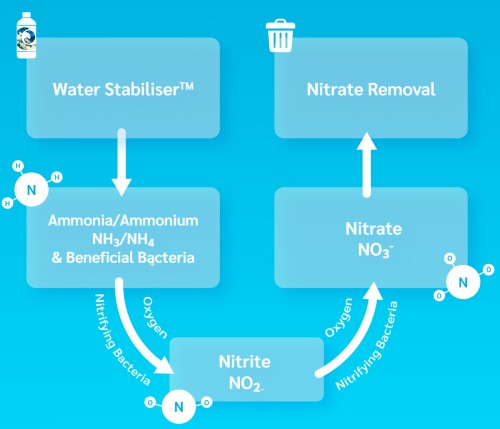How to Cycle Your Aquarium Quickly and Efficiently
Cycling an aquarium is a critical step in establishing a healthy aquatic environment for your fish and other inhabitants. However, this process can often be time-consuming and challenging. In this comprehensive guide, we’ll explore the ins and outs of aquarium cycling and how the innovative product Water Stabilizer™ can streamline the process, making it easier and more efficient.
Understanding Aquarium Cycling:
Aquarium cycling is the process of establishing beneficial bacteria colonies within the tank that help break down harmful substances such as ammonia and nitrite, converting them into less harmful compounds like nitrate, which is more easily removed from the system. These bacteria are essential for maintaining water quality and ensuring the health and well-being of your aquarium’s inhabitants.
This is known as the nitrogen cycle, and it exists in all water ecosystems. Each one of Quantum’s Aquarium Aqua Care Guides explains the nitrogen cycle specific to the type of aquarium you have, but the general nitrogen cycle is as follows:
- Ammonia/Ammonium, also known as Total Ammonia Nitrogen or ‘TAN’ for short, is introduced by bacteria feeding on inhabitant waste or direct supplementation
- Nitrifying bacteria (Nitrosomonas) use oxygen to convert ammonium into nitrite
- Another bacteria, Nitrobacter, uses more oxygen to convert nitrite into nitrate
- Nitrate is removed from the system by one or more of the following methods:
- Water Change (All aquariums)
- Denitrifying bacteria converting nitrate to nitrogen gas (Saltwater)
- Plant Uptake (Planted Freshwater)
- Nitrate Removing Resin (Fish-Only Freshwater)

You will be able to know that your aquarium is cycled when the following occurs:
- TAN is 0ppm
- Nitrite is 0ppm
- Nitrate is >0.1ppm
These conditions are indicators that the beneficial bacteria is present and doing its job by converting TAN to nitrite then to nitrate. Once the aquarium is cycled, these bacteria will constantly work to remove TAN and nitrite that gets introduced by inhabitant wastes or decaying matter.

How Water Stabilizer™ Can Help:
Water Stabilizer™ is a revolutionary solution to expedite the cycling process and create a healthier aquarium environment in a fraction of the time. This unique formulation contains a blend of beneficial bacteria, along with its food sources: ammonium and nitrate, which work together to kickstart the nitrogen cycle and accelerate the establishment of a stable ecosystem.
By adding Water Stabilizer™ to your aquarium, you can reduce the cycling time from weeks to just a few days, allowing you to introduce fish sooner and enjoy a thriving aquarium with minimal hassle. However, it is recommended to continue the cycling process for a full week to ensure that any potential complications are mitigated. Additionally, Water Stabilizer™ helps maintain water clarity and stability, promoting the growth of beneficial bacteria and supporting overall aquarium health. Water Stabilizer™ can also be used in regular water changes after cycling to maintain beneficial bacteria levels.

Differences in Cycling Saltwater and Freshwater Aquariums:
While the basic principles of aquarium cycling apply to both saltwater and freshwater setups, there are some key differences to consider:
Nitrogen Sources:
- In freshwater aquariums, the primary source of nitrogen is typically ammonia, which is produced by fish waste and decaying organic matter. In saltwater aquariums, ammonia and nitrite can also be present, and may be more prevalent due to the use of non-cycled live rock and other biological filtration methods.
pH and Alkalinity:
- Saltwater aquariums usually have higher pH and alkalinity levels compared to freshwater systems (except for some African Lake environments). This can affect the cycling process, as different species of beneficial bacteria thrive in specific pH ranges. Water Stabilizer™ is formulated to work effectively in a wide range of pH levels, making it suitable for both freshwater and saltwater aquariums.
Salinity/TDS Levels:
- Maintaining stable salinity levels is crucial in saltwater aquariums, as fluctuations can stress fish and disrupt the cycling process. These TDS levels also play a role in the development of beneficial bacteria as they directly affect the water environment. Water Stabilizer™ is designed to function in all types of aquarium environments, regardless of TDS and salinity.

Conclusion:
Cycling your aquarium is a vital step in creating a healthy and thriving aquatic environment for your fish and other inhabitants. With the help of Water Stabilizer™, you can expedite the cycling process and enjoy a stable and balanced aquarium in no time. Whether you’re setting up a freshwater or saltwater tank, Water Stabilizer™ offers a convenient and effective solution for achieving optimal water quality and promoting the well-being of your aquarium inhabitants for both your initial start-up and ongoing maintenance.
Happy Aquarium Keeping!
Written by
No comments







0 comments